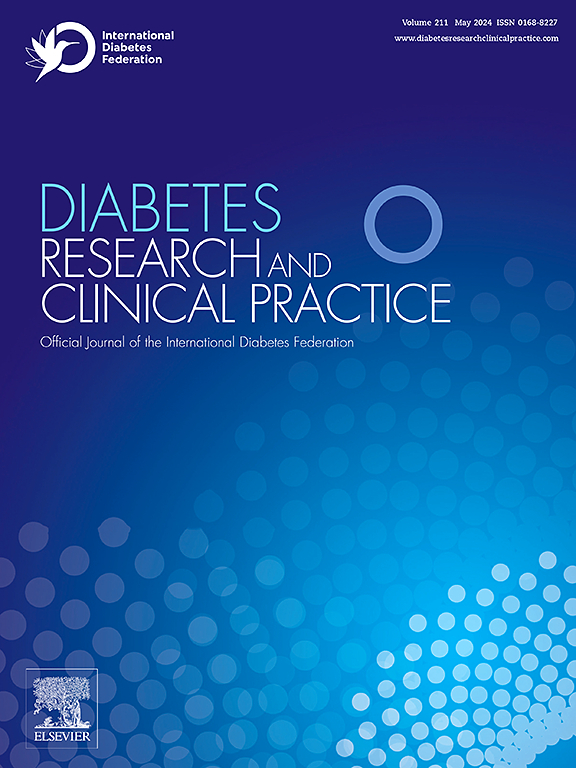Which adiposity index is best? Comparison of five indicators and their ability to identify type 2 diabetes risk in a population study
IF 6.1
3区 医学
Q1 ENDOCRINOLOGY & METABOLISM
引用次数: 0
Abstract
Aims
We compared ability of five adiposity indicators [body mass index (BMI), waist circumference (WC), waist-to-height ratio (WHtR), waist-by-height0.5 (WHT.5R), and a body shape index (ABSI)] to identify current diabetes and their prospective associations with diabetes.
Methods
Baseline data were from 7,979 participants of UK Whitehall II study, of whom 7,488 diabetes-free participants were followed-up (median = 16.0 years) for incident diabetes (n = 940). According to five indices’ cut-points, participants were separately classified into low-value groups and high-value groups. We cross-sectionally investigated ability of the indicators to identify existing diabetes by receiver operating characteristic curve analysis, and explored prospective associations between elevated indices and diabetes using Cox regression analysis.
Results
Waist-based indicators were superior to BMI in identifying diabetes. High WHtR (≥0.5) demonstrated the highest multivariable-adjusted HR [2.64 (95 % CI 2.29, 3.03)]. Across all indicators, associations between elevated indicators and diabetes were stronger in younger participants. In combined analyses, “low BMI but high WHtR” had higher risk for diabetes [2.20 (95 % CI 1.65, 2.95)] than “high BMI but low WHtR” [1.34 (95 % CI 1.05, 1.70)].
Conclusion
Waist-based indicators are more strongly associated with diabetes than BMI. WHtR, an easy-to-calculate, waist-based index with a sex- and race-independent cut-point, may be useful for diabetes prevention.
哪种肥胖指数最好?人口研究中5个指标及其识别2型糖尿病风险的能力的比较
目的:我们比较了五种肥胖指标[体重指数(BMI)、腰围(WC)、腰高比(WHtR)、腰高比0.5 (WHT.5R)和体型指数(ABSI)]识别当前糖尿病及其与糖尿病的潜在关联的能力。方法基线数据来自英国Whitehall II研究的7,979名参与者,其中7,488名无糖尿病参与者(n = 940)进行了糖尿病事件随访(中位= 16.0年)。根据五个指标的分界点,将参与者分为低价值组和高价值组。我们通过受试者工作特征曲线分析对指标识别糖尿病的能力进行了横断面调查,并利用Cox回归分析探讨了指标升高与糖尿病之间的潜在关联。结果以腰围为基础的指标对糖尿病的诊断优于BMI。高WHtR(≥0.5)显示最高的多变量调整HR [2.64 (95% CI 2.29, 3.03)]。在所有指标中,指标升高与糖尿病之间的关联在年轻参与者中更强。在综合分析中,“低BMI但高WHtR”的糖尿病风险[2.20 (95% CI 1.65, 2.95)]高于“高BMI但低WHtR”[1.34 (95% CI 1.05, 1.70)]。结论腰围指标与糖尿病的相关性高于BMI指标。WHtR是一种易于计算的基于腰围的指数,具有与性别和种族无关的临界值,可能对糖尿病预防有用。
本文章由计算机程序翻译,如有差异,请以英文原文为准。
求助全文
约1分钟内获得全文
求助全文
来源期刊

Diabetes research and clinical practice
医学-内分泌学与代谢
CiteScore
10.30
自引率
3.90%
发文量
862
审稿时长
32 days
期刊介绍:
Diabetes Research and Clinical Practice is an international journal for health-care providers and clinically oriented researchers that publishes high-quality original research articles and expert reviews in diabetes and related areas. The role of the journal is to provide a venue for dissemination of knowledge and discussion of topics related to diabetes clinical research and patient care. Topics of focus include translational science, genetics, immunology, nutrition, psychosocial research, epidemiology, prevention, socio-economic research, complications, new treatments, technologies and therapy.
 求助内容:
求助内容: 应助结果提醒方式:
应助结果提醒方式:


